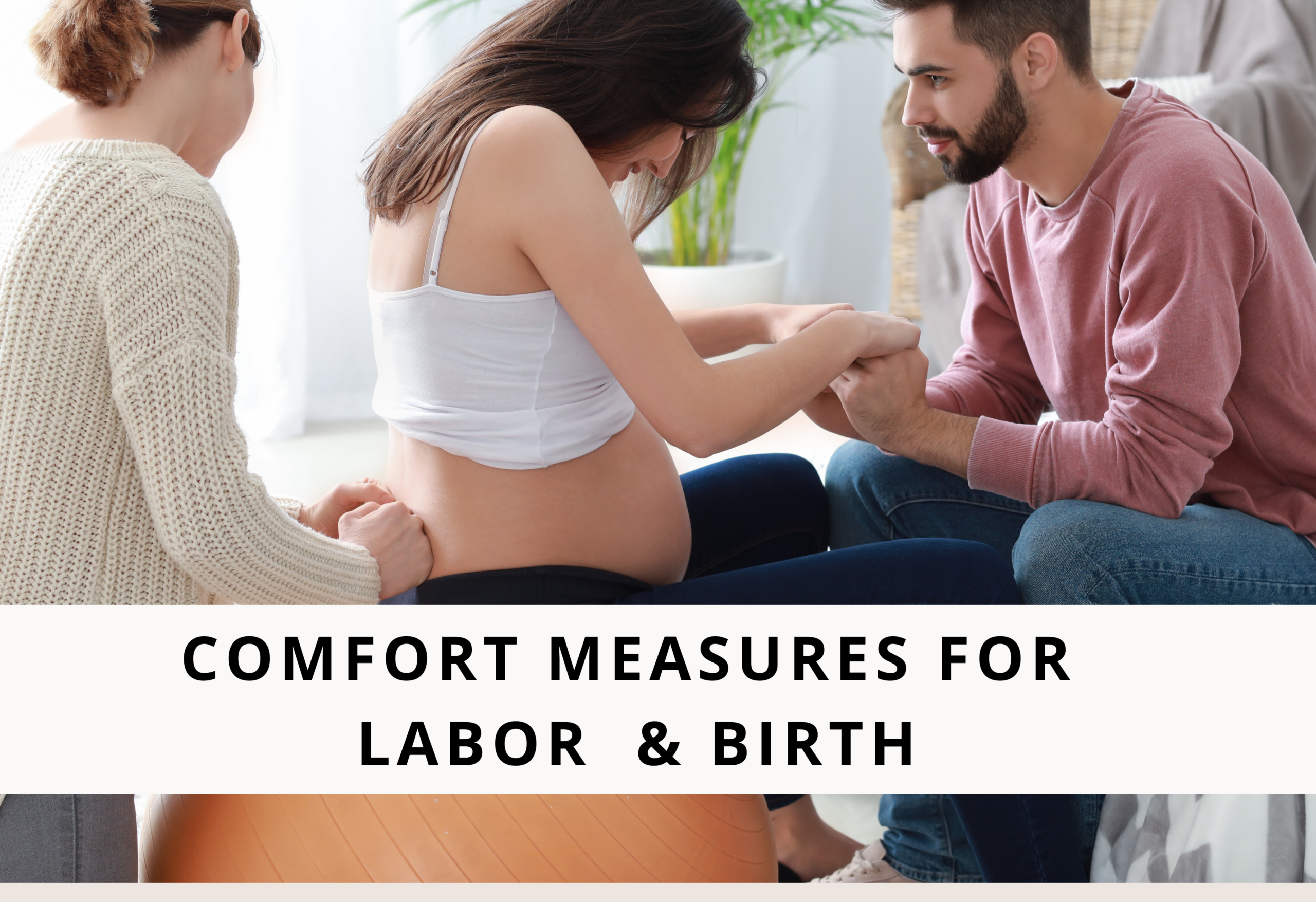Table of Contents
As you start to prepare for the arrival of your baby, it’s important to familiarize yourself with helpful comfort measures that can help you cope with the sensations and challenges of labor and birth. This is my guide for expecting parents and support people on different techniques and strategies that can enhance your comfort during your labor experience. Remember, every labor is unique, so explore different options and work closely with your healthcare provider or birth support team to find what works best for you.
1. Breathing Techniques

2. Movement and Positions
Part of labor is encouraging your baby to move down in to the pelvis and providing them the ability to maneuver by changing your body’s position. Movment during labor is absolrely critical, even if you are planning on getting an epidural, you can move your body for your baby using peanut balls and the hospital bed to keep movement in your hips and body.
Walking, dancing, or swaying with your partner or support person, are great ways to stay moving. By moving around during labor you can encourage progress towards meeting your baby. It can also be helpful to use a birth ball or sway your hips to ease discomfort and encourage the baby’s descent. Experiment with different positions like standing, kneeling, squatting, or leaning on a support person or furniture to find what feels best for you. It can be helpful to change positions every 30 minutes and using the restroom in between these changes or every other change.
As a doula and student midwife, I have witnessed parents ‘get stuck’ mentally and physically in a position because they are afraid to move or worried that the next position might be more uncomfortable. My tip to parents is that the only way out of the discomfort is through, and that means moving to help labor progress. The first 1-3 contractions after changing positions may feel a bit more intense than the last position, but your body will often settle into the new position. When it comes to picking positions, it is great to move your body along to what feels intuitive but if you need help, you can ask your birth team for suggestions.

3. Massage and Touch
One of my personal favorite comfort measures for labor is counter pressure! This is when your partner or support person applies firm pressure to your lower back or hips during contractions to relieve discomfort. You can practice these prenatally so your partner knows how to perform counter pressure to your unique body. You may also plan on using counter pressure and then the day of your labor arrives and you find it isn’t your favorite thing.
Massage is also a wonderful comfort measure for labor. Someone can gently massage your shoulders, lower back, or feet to relax tense muscles. As a doula, I bring massage oils and essential oils safe for pregnancy to my families births to use for relaxing massage. Want to learn how I use essential oils during labor and birth? Click Here. Or learn more about which oils I use more by Clicking Here.
You can also utilize warm compresses during labor and also during the pushing phase of labor. I bring a heating pad along with me to my client’s births to use on their lower backs during labor. You can combine counter pressure with the heating pads for bonus comfort! It is important to be mindful about how long you use the heating pad or how hot the heating pad is. You want to provide comfort during labor but not overheat the parent. I always use a lower setting out of caution.
During the pushing phase your health care provider or you can apply a warm compress to your perineum. You will want to discuss using warm compress during the pushing phase ahead of time so your birth team can make sure they are available for use.
4. Hydrotherapy
Feel like you are stuck in a mental loop during labor? Showering is like a human version of a ‘turning it off and turning it back on again’ option. Allow the shower’s warm water to cascade over your body during labor to promote relaxation. You can add a birth ball in your shower to sit on or to lean onto in hands in knees. Just make sure you have a support person close by to assist you. Also, you can sprinkle an essential oil or two in the shower for some additional aromatherapy.
Bathing is also an option! Immerse yourself in a warm tub to relieve tension and promote a sense of calm. The water cannot be too warm or you could overheat yourself and baby.You will want to ensure you are getting plenty of hydration when using this option as well.
5. Relaxation Techniques
Practicing relaxation techniques like hypnobirthing prenatally is a key to their usefulness as a comfort measure for labor. You can use guided imagery like listening to soothing music, nature sounds, or guided meditation to induce relaxation.
Aromatherapy is when you use essential oils with calming scents, such as lavender, to create a serene environment. Want to learn how I use essential oils during labor and birth? Click Here. Or learn more about which oils I use more by Clicking Here.
Dim Lighting can create a cozy ambiance for labor. Use soft lighting or candlelight to foster relaxation.
6. Emotional Support
A birth partner can be the most amazing comfort measure for labor and birth! You can ask a trusted partner, family member, or doula provide continuous emotional support throughout labor. As a doula, I provide informational, emotional, and physical support during the pregnancy, labor, birth, and postpartum journeys of my families. I help expecting parents prep for their birth journey by providing empowering resources that compliment their birth goals.
Affirmations are another great emotional support comfort measure. You can recite positive affirmations or phrases that encourage confidence, strength, and trust in your body’s ability to birth. Tell your birth team which affirmations you feel most moved or inspired by and they can remind your of them while supporting you. Create art out of your affirmations and hang them in your birth space.
In conclusion about comfort measures for Labor and Birth
Remember, these comfort measures for labor are not exhaustive, and you can tailor them to your preferences. It is important to communicate your birth preferences and preferred comfort measures with your healthcare provider and birth support team. I encourage my doula families to begin having conversations about their birth preferences and comfort measures early on in their pregnancy. This way they can find out if their provider or birth team aligns with their goals and make changes if necessary. As you navigate labor and birth, trust in your inner strength and remember that you have a team of individuals supporting you on this remarkable journey.





